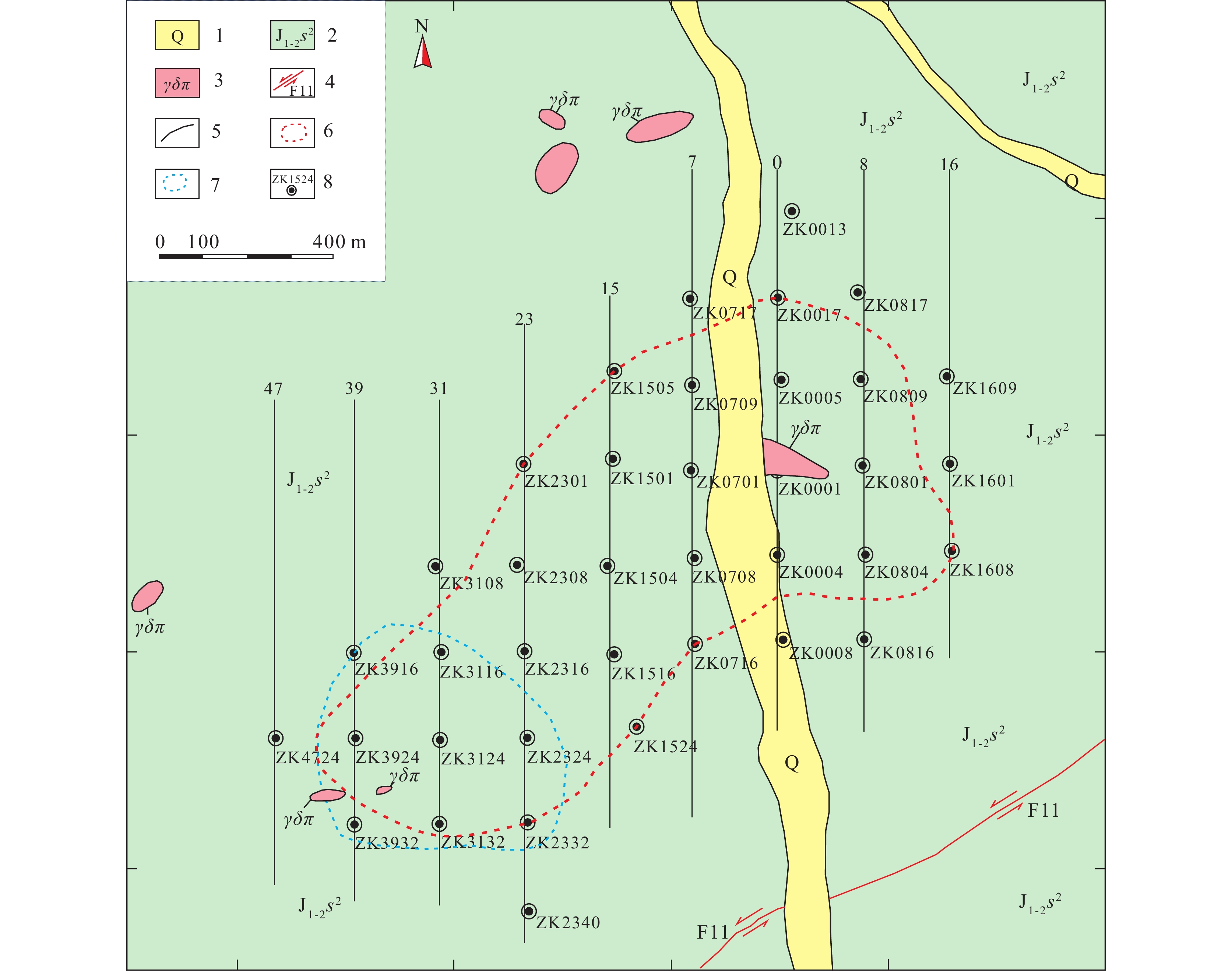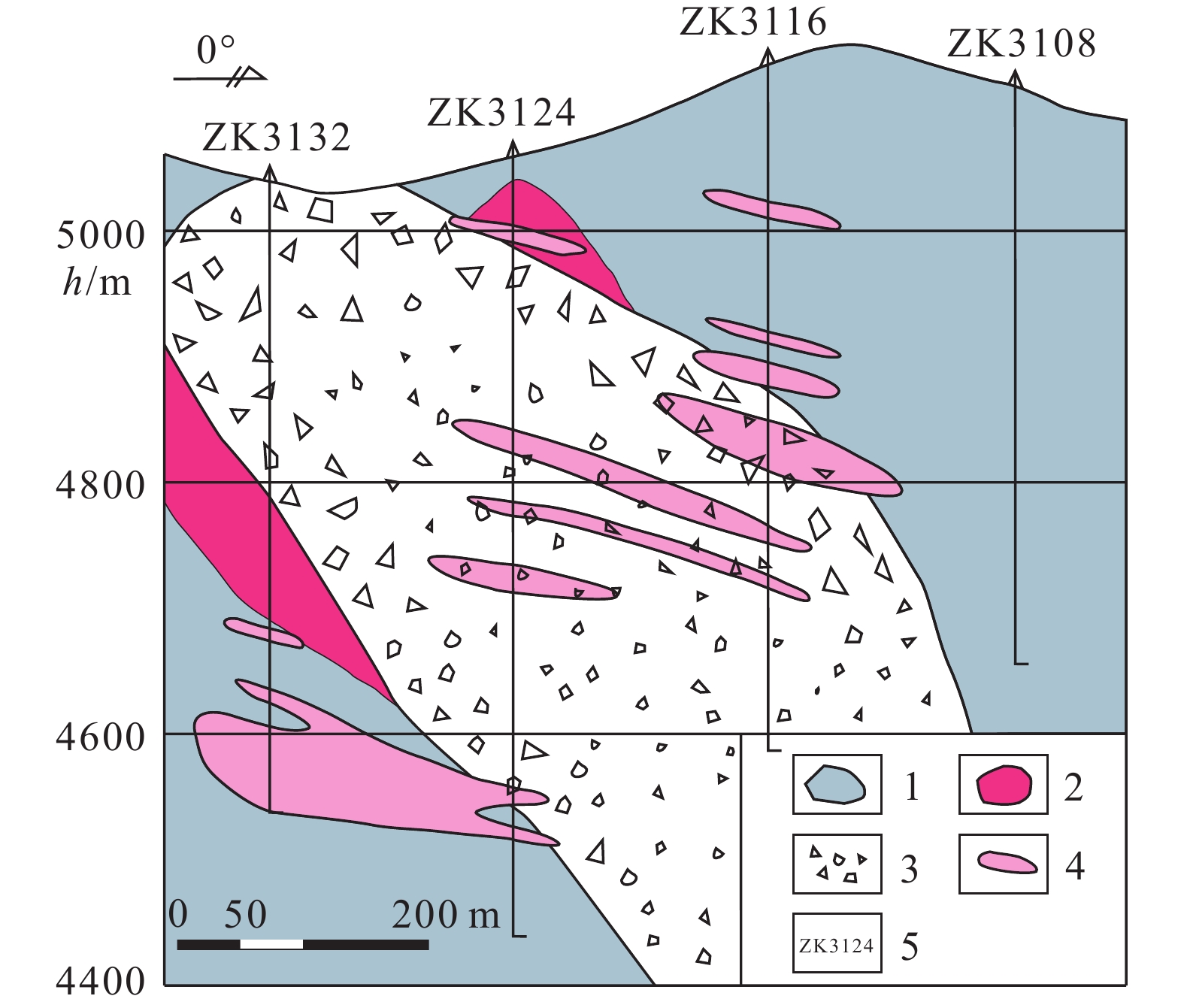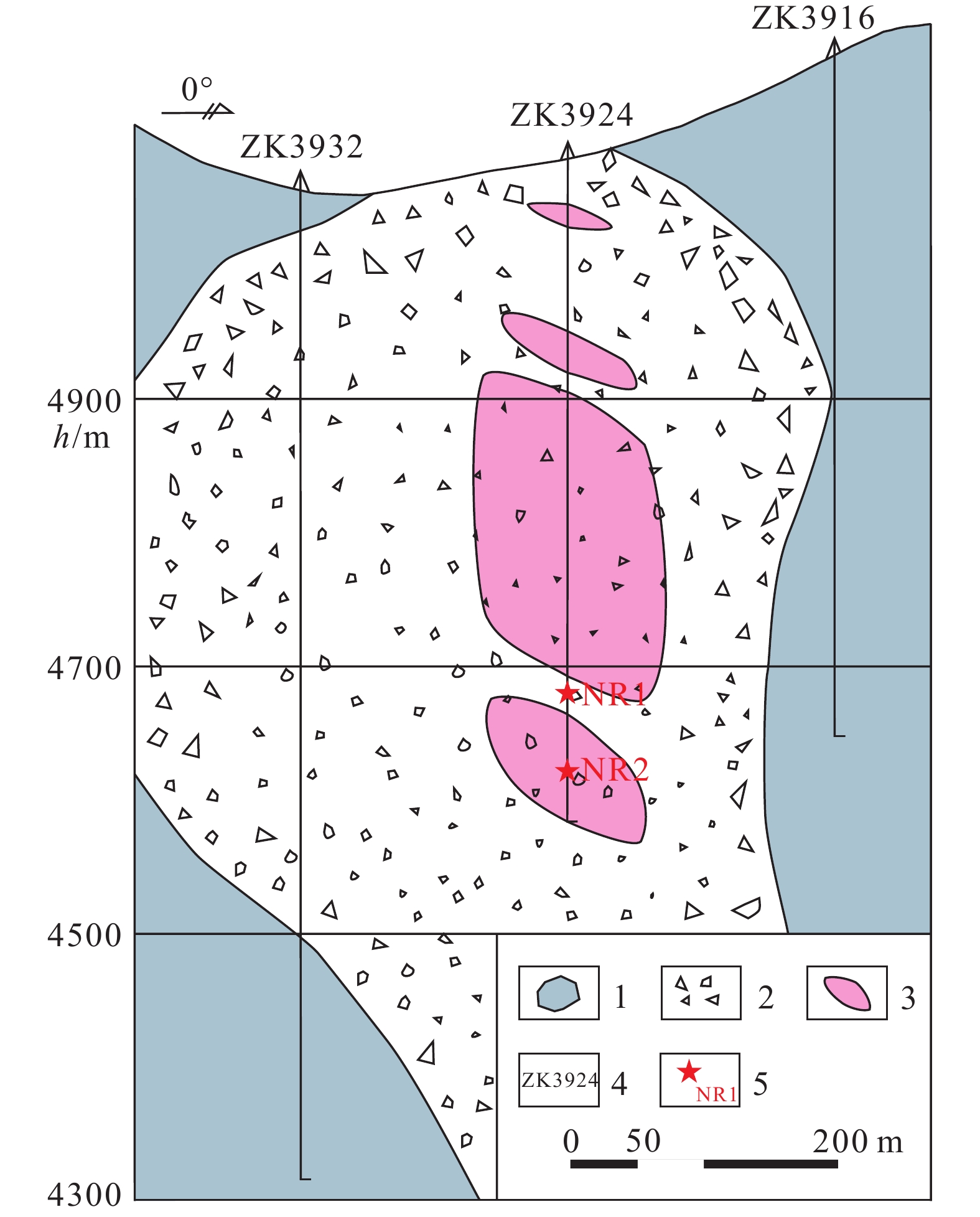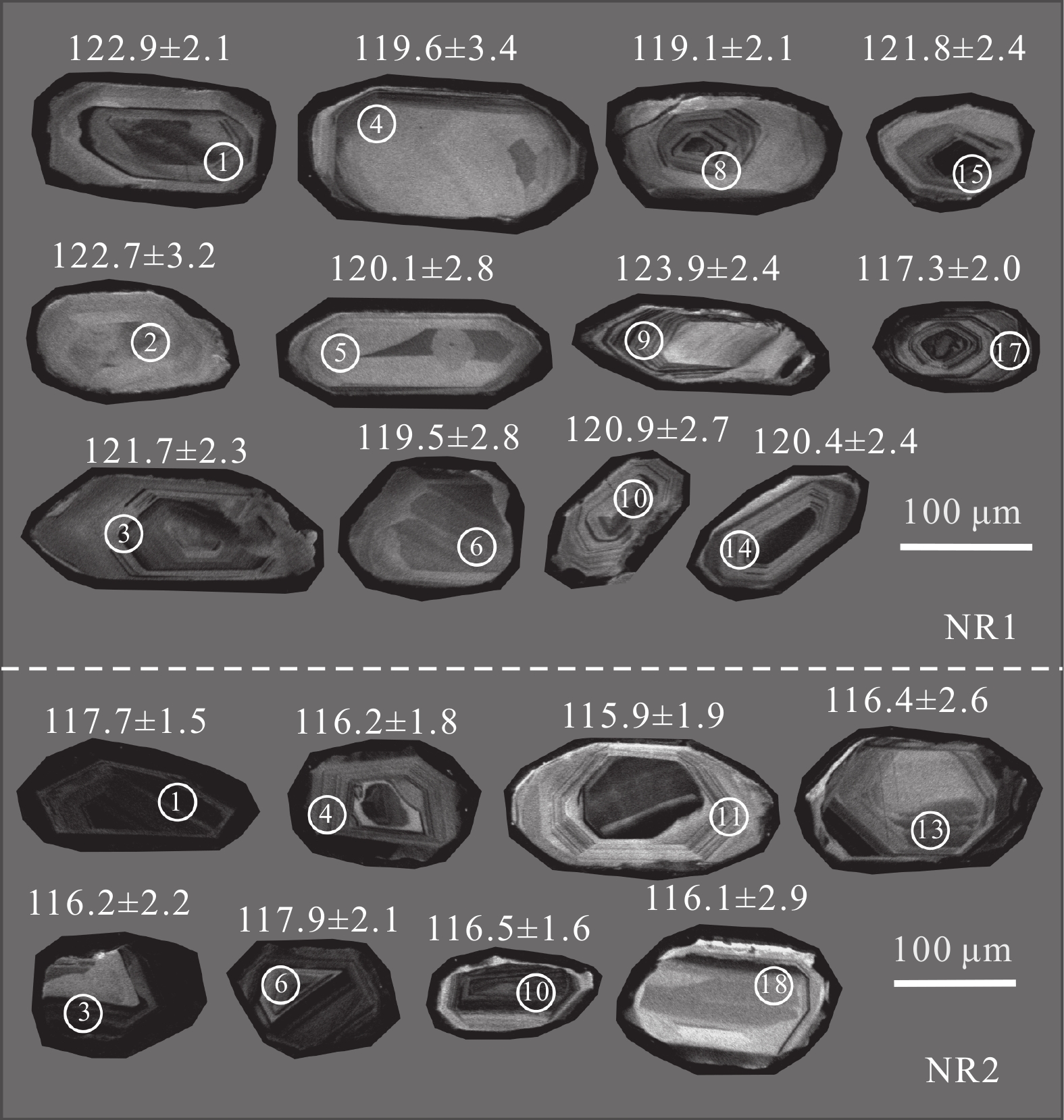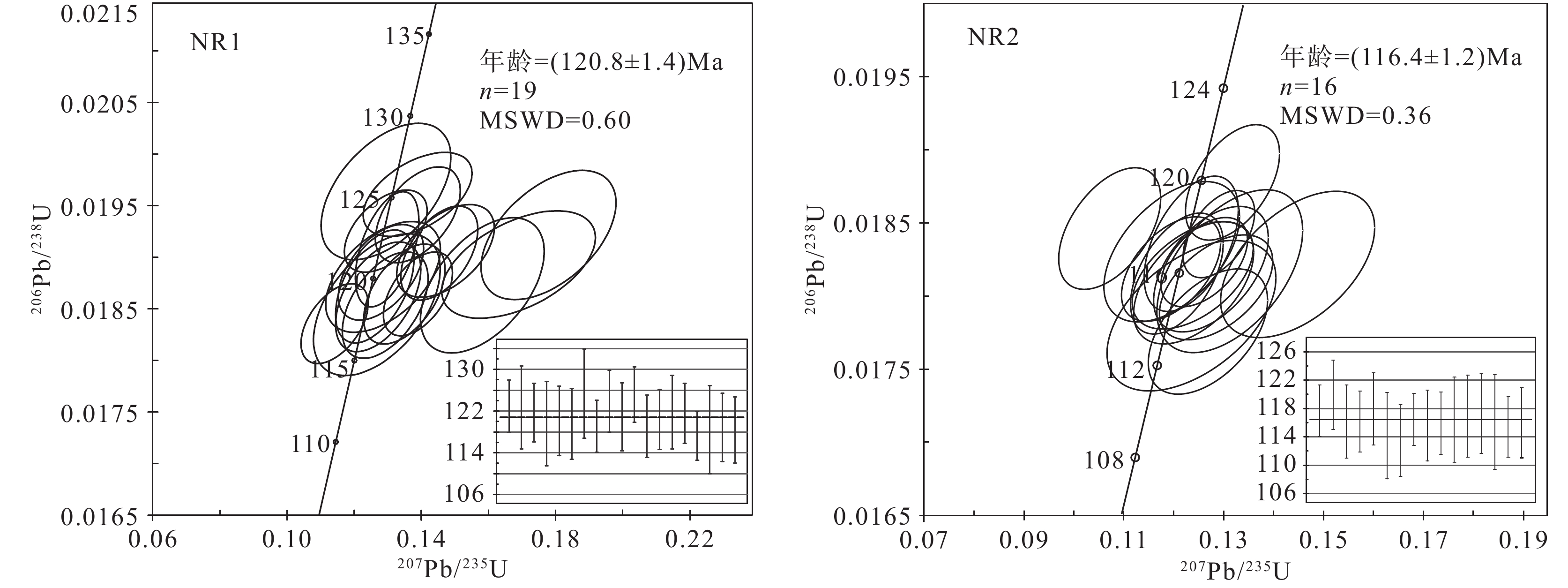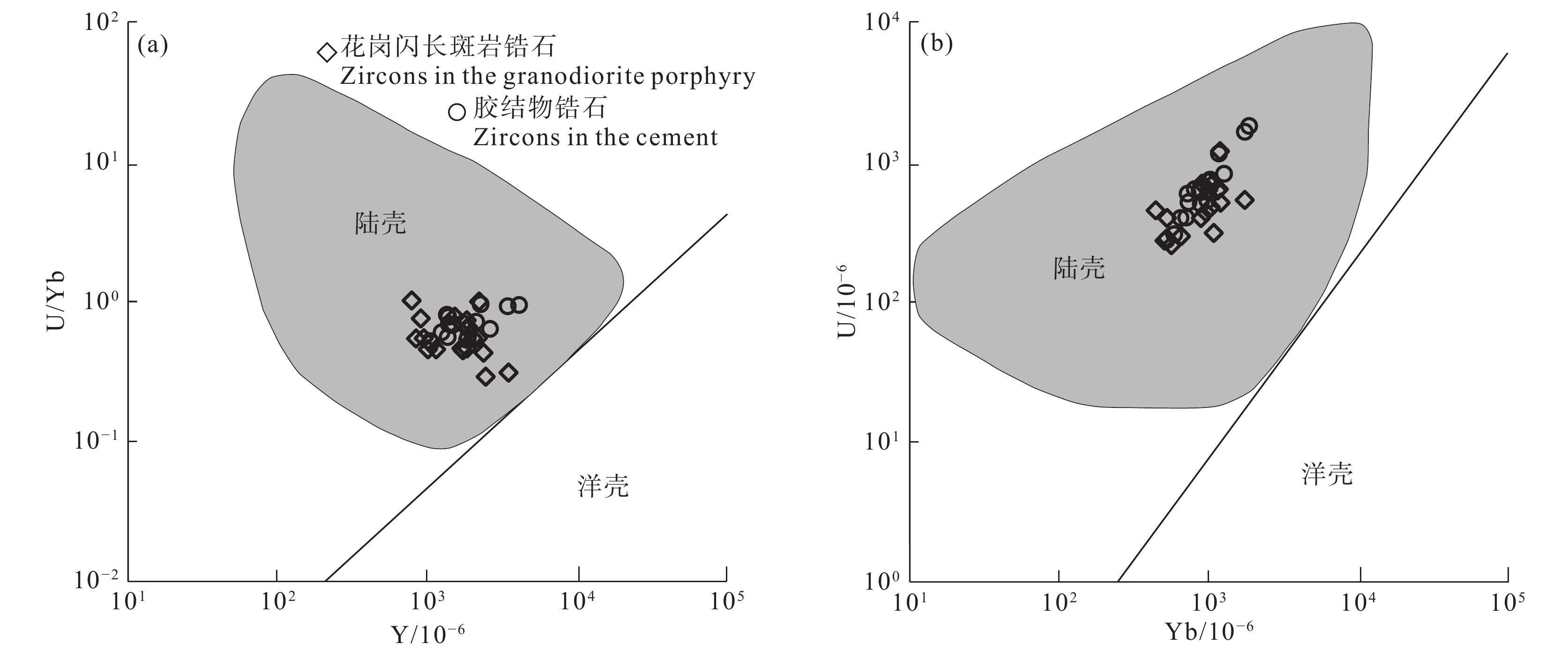Constraints on metallogenic age from cryptoexplosive breccia in Naruo Cu(Au) deposit, Xizang
-
摘要:
研究目的 拿若矿床是多龙矿集区4个超大型矿床之一,由斑岩型和角砾岩型矿体组成。斑岩型矿体研究资料丰富,角砾岩矿体研究程度较浅,隐爆作用与成矿作用的时代关系还缺乏详细的研究。隐爆角砾岩整体呈筒状产出,角砾成分为长石石英砂岩和花岗闪长斑岩,胶结物成分主要为岩粉。
研究方法 本次研究旨在通过年代学证据探讨隐爆角砾岩形成与成矿的时代关系。
研究结果 锆石矿物学显示花岗闪长斑岩(NR1)锆石边部发生溶蚀边,震荡环带减弱,未彻底重结晶;胶结物(NR2)锆石结晶较好,震荡环带清晰。两种样品的锆石微量元素特征显示,两期岩浆源区均为陆壳环境;稀土配分曲线均较陡,富集重稀土,亏损轻稀土;具有显著的正Ce异常和负Eu异常。LA−ICP−MS锆石U−Pb定年结果显示,花岗闪长斑岩的锆石206Pb/238U年龄为117.3~125.4 Ma,加权平均年龄为(120.8±1.4)Ma,成岩时间在120.8 Ma左右;胶结物的锆石206Pb/238U年龄为113.5~119.9 Ma,加权平均年龄为(116.4±1.2)Ma,隐爆时代在116.4 Ma左右。
结论 拿若矿床共发生两期成岩作用,分别为~120 Ma和~117 Ma。拿若矿床成矿作用发生在116~117 Ma,而非~120 Ma。根据年代学证据认为,成矿作用和隐爆作用受同期岩浆作用控制,隐爆作用在前而成矿作用在后,岩浆演化在时间和空间上存在差异。
Abstract:This paper is the result of mineral exploration engineering.
Objective The Naruo deposit is one of four super large deposits in Duolong ore district. It is composed of porphyry and breccia type orebodies. Previous researches have focused on porphyry orebody, while the research on cryptoexplosive breccia ore bodies is relatively weak. The temporal relationship between cryptic explosion processes and mineralization remains inadequately studied. The cryptoexplosive breccia is generally produced in a cylindrical shape, with the breccia composed of feldspar quartz sandstone and granodiorite porphyry, and the cement mainly composed of rock powder.
Methods This study is to explore the age relationship between the formation and mineralization of cryptoexplosive breccia through chronological evidence.
Results Zircon mineralogy shows that the zircon edge of the granite diorite porphyry (NR1) is characterized by dissolution, weak oscillation zone, and incomplete recrystallization. Zircons in cement (NR1) is characterized by fine crystalline form, clear oscillatory zone. The trace element characteristics of these two types of zircons show that the source of two stages of magma is continental crust. The rare earth distribution curves are relatively steep, with enrichment of heavy rare earth elements, loss of light rare earth elements, significant positive Ce and negative Eu anomalies. LA−ICP−MS zircon U−Pb dating results show that the zircon 206Pb/238U age of granite diorite porphyry is between 117.3 Ma and 125.4 Ma, with weighted average age of (120.8±1.4) Ma, indicating the diagenetic age of 120.8 Ma. The zircon 206Pb / 238U age of cement is between 113.5 Ma and 119.9 Ma, with weighted average age of (116.4±1.2) Ma, indicating the cryptoexplosive age of 116.4 Ma.
Conclusions The results in this study show two stages of diagenesis in Naruo deposit, ~120 Ma and ~117 Ma, respectively. Mineralization occurred between 116 Ma and 117 Ma, rather than ~120 Ma. The chronological data shows that the mineralization and cryptoexplosion are controlled by contemporaneous magmatism, with cryptoexplosion occurring first and mineralization occurring later, and there are differences in the time and space of magma evolution.
-

-
图 1 多龙矿集区地质图(据杨超等, 2014; Xu et al., 2015)
Figure 1.
图 2 拿若铜(金)矿区地质图(据高轲等, 2016,2023)
Figure 2.
图 3 拿若矿床31 号勘探线剖面图(据高轲等, 2016)
Figure 3.
图 4 拿若矿床39号勘探线剖面图(据高轲等, 2016)
Figure 4.
图 7 拿若隐爆角砾岩锆石球粒陨石标准化稀土元素配分曲线(底图据路远发,2004)
Figure 7.
图 9 锆石Y−U/Yb图解(a)和Yb−U图解(b)(底图据Grimes et al., 2007)
Figure 9.
表 1 拿若隐爆角砾岩锆石稀土元素分析结果(10−6)
Table 1. Rare earth elements in zircons of cryptoexplosive breccias in the Naruo deposit (10−6)
测点 La Ce Pr Nd Sm Eu Gd Tb Dy Ho Er Tm Yb Lu ΣREE LREE/
HREEδEu δCe 样号NR1 1-1 0.024 51.84 0.143 1.48 4.18 2.21 33.6 13.04 158.4 75.3 378.4 102.6 1130 291.2 2242.4 0.03 0.40 105.5 1-2 0.024 24.85 0.064 1.1 2.61 1.15 18.4 6.1 82.4 36.6 186.8 50.5 554 142.4 1107.0 0.03 0.37 104.8 1-3 0.01 34.05 0.016 0.41 2.03 1.05 19.8 8.68 119.7 56.1 292.4 81.8 884 225.8 1725.9 0.02 0.33 528.3 1-4 0.01 24.86 0.033 0.38 3.00 1.13 12.3 5.84 75.1 34.3 172.8 47.6 517 133.3 1027.7 0.03 0.49 208.6 1-5 0.025 35.57 0.228 3.44 9.67 2.62 48.4 18.16 227.3 96.8 442.4 109.5 1064 249.0 2307.1 0.02 0.30 46.4 1-6 0.01 32.62 0.103 2.07 4.33 2.04 29.4 10.83 142.2 65.1 310.6 84.8 874 215.1 1773.2 0.02 0.41 94.6 1-7 0.267 28.97 0.224 2.19 3.59 1.28 19.8 7.99 90.9 42.1 213.9 60.3 643 166.4 1280.9 0.03 0.37 27.2 1-8 0.024 42.69 0.08 2.01 5.92 1.61 32.1 12.84 171.7 83.1 413.6 112.3 1150 290.8 2318.8 0.02 0.28 147.9 1-9 0.026 57.34 0.172 2.74 8.69 4.49 53.8 22.07 283.5 130.5 640.7 170.5 1713 411.6 3499.1 0.02 0.49 97.6 1-10 0.128 36.63 0.067 1.25 6.11 2.54 28.6 12.68 144.5 69.3 351.4 97.1 1016 263.7 2030.0 0.02 0.49 96.1 1-11 0.025 47 0.066 2.24 5.84 2.35 33.7 12.31 151.9 71 337.3 91.7 971 242.3 1968.7 0.03 0.40 191.9 1-12 0.109 37.65 0.267 3.33 7.75 3.22 45.9 15.84 206.7 90.4 442 114.8 1177 286.6 2431.6 0.02 0.41 37.6 1-14 0.01 34.28 0.049 2.24 4.5 1.41 28.9 10.13 137.5 64 316.6 87.1 938 239.8 1864.5 0.02 0.29 200.8 1-15 0.556 32.17 0.4 2.59 5.43 1.91 35.4 15.01 176.6 80.8 402.7 112.4 1167 285.4 2318.4 0.02 0.32 16.0 1-16 0.05 49.33 0.05 1.41 3.92 1.89 26.6 11.21 141.6 69.4 348.8 96.4 1059 266.6 2076.3 0.03 0.42 218.7 1-17 0.01 50.6 0.12 1.76 4.7 1.56 25.5 11.38 150 70.1 343.5 91.7 977 241.1 1969.0 0.03 0.35 126.7 1-18 0.01 21.37 0.011 1.87 3.01 1.14 13.1 4.64 61.4 28.8 156.6 44.4 498 130.7 965.1 0.03 0.47 442.1 1-19 0.01 32.48 0.01 1.27 2.67 0.82 14.8 5.52 70.9 32.4 164.9 46.1 517 135.6 1024.5 0.04 0.32 719.8 1-20 0.01 26.1 0.072 1.14 1.54 0.77 11.6 4.82 59.8 28.4 140.7 40 436 113 864.0 0.04 0.40 106.6 样号NR2 2-1 0.087 72.24 0.117 5.67 9.81 4.18 62.4 23.44 268.6 125.5 603.7 165.3 1725 432.4 3498.4 0.03 0.39 147.7 2-2 0.010 187.11 0.059 3.53 11.75 4.72 70.3 28.72 335.2 148.5 708.1 180.2 1845 439.3 3962.5 0.06 0.39 921.94 2-3 0.010 40.77 0.161 3.84 6.47 2.97 36.9 13.07 163 70.3 325.5 86.6 878 212.7 1840.3 0.03 0.46 76.7 2-4 0.046 44.14 0.2 2.6 7.78 2.35 35.9 13.56 174 76.5 379 99.6 1014 255.7 2105.4 0.03 0.36 62.7 2-5 0.010 47.69 0.143 1.87 3.02 1.52 22.3 8.12 107 51 265.7 77.1 869 229.8 1684.3 0.03 0.41 100.7 2-6 0.026 28.11 0.086 1.86 3.44 0.78 15.6 5.96 78.4 37 191.6 53.6 582 151.9 1150.4 0.03 0.27 90.5 2-7 0.065 61.36 0.144 4.17 9.04 3.74 49.5 18.51 212.7 96.9 459.4 118.3 1252 301.9 2587.7 0.03 0.43 112.0 2-8 0.042 48.95 0.194 3.13 6.15 3.34 39 14.06 179.5 81.5 388.4 109.7 1161 295.3 2330.3 0.03 0.50 72.1 2-9 0.010 44.62 0.132 1.59 4.59 2.06 26.4 10.06 133.6 63.9 327.7 91.6 968 248.2 1922.5 0.03 0.45 101.9 2-10 0.010 42.56 0.057 1.05 3.8 1.93 28 10.8 132.4 61.8 293 79.6 863 214.0 1732.0 0.03 0.41 216.6 2-11 0.010 29.99 0.1 2.45 4.24 2.33 21.1 7.9 97.3 43.5 212.8 59.6 643 172.1 1296.4 0.03 0.62 89.5 2-12 0.010 35.24 0.145 1.16 4.15 1.93 23.6 8.86 105.1 48.2 246.2 68.9 725 187.1 1455.6 0.03 0.47 73.4 2-13 0.010 30.26 0.071 2.99 5.62 2.17 25.2 8.49 107.7 48 232.6 64.9 702 179.6 1409.6 0.03 0.47 125.3 2-14 0.022 25.79 0.059 0.89 1.83 1.63 16.1 6.54 80.8 36 174.3 48.7 518 132.1 1042.8 0.03 0.62 118.06 2-15 0.023 48.39 0.035 1.06 3.45 1.29 18.5 7.57 101.1 48.2 243.4 71.4 800 216.6 1561.0 0.04 0.40 339.7 2-16 0.010 47.74 0.099 0.8 2.02 1.14 20.5 7.55 95.5 46.5 237.6 66.9 716 180.5 1422.9 0.04 0.35 143.9 表 2 拿若矿床隐爆角砾岩(NR1)及角砾岩筒胶结物(NR2)LA−ICP−MS锆石U−Pb年龄分析结果
Table 2. LA−ICP−MS zircon U−Pb results of cryptoexplosive breccias (NR1) and cement (NR2) in the Naruo deposit
测点 元素含量/10−6 Th/U 同位素比值 年龄/Ma Pb Th U 207Pb/206Pb 1σ 207Pb/235U 1σ 206Pb/238U 1σ 206Pb/238U 1σ 隐爆角砾岩NR1 1-1 26.07 399.2 622 0.64 0.04939 0.0042 0.12935 0.01007 0.01925 0.00033 122.9 2.1 1-2 11.21 160.46 254.46 0.63 0.06806 0.00669 0.17787 0.01642 0.01922 0.00051 122.7 3.2 1-3 22.23 272.67 697.52 0.39 0.0576 0.00516 0.14717 0.01187 0.01906 0.00037 121.7 2.3 1-4 11.04 164.65 284.41 0.58 0.06571 0.00711 0.15816 0.01506 0.01873 0.00054 119.6 3.4 1-5 15.23 234.5 310.09 0.76 0.05332 0.00631 0.12856 0.01396 0.01881 0.00044 120.1 2.8 1-6 19.2 344.41 394.8 0.87 0.05077 0.00453 0.12611 0.00956 0.01872 0.00045 119.5 2.8 1-7 13.73 201.83 295.16 0.68 0.05053 0.00641 0.12944 0.01579 0.01964 0.00054 125.4 3.4 1-8 24.52 357.57 637.32 0.56 0.05658 0.00406 0.13896 0.0084 0.01865 0.00033 119.1 2.1 1-9 23.01 366.7 533.77 0.69 0.05372 0.00454 0.13892 0.01033 0.01941 0.00038 123.9 2.4 1-10 20.42 316.27 472.98 0.67 0.06855 0.00835 0.16893 0.01872 0.01893 0.00043 120.9 2.7 1-11 33.14 523.19 721.77 0.72 0.05053 0.00446 0.13886 0.01326 0.01961 0.00033 125.2 2.1 1-12 23.72 401.2 510.82 0.79 0.05559 0.00463 0.13491 0.00989 0.01864 0.0004 119.1 2.5 1-14 17.06 262.92 437.62 0.6 0.05063 0.00466 0.12795 0.01037 0.01885 0.00038 120.4 2.4 1-15 37.24 481.77 1185.09 0.41 0.05166 0.00335 0.12978 0.00772 0.01908 0.00046 121.8 2.9 1-16 29.21 391.31 706.28 0.55 0.05677 0.00399 0.14534 0.00937 0.01904 0.00037 121.6 2.4 1-17 25.21 451.07 629.89 0.72 0.04563 0.00331 0.11412 0.00817 0.01836 0.00032 117.3 2.0 1-18 10.21 161.46 273.24 0.59 0.05522 0.0075 0.12671 0.01543 0.01854 0.00056 118.4 3.6 1-19 16.98 252.62 395.92 0.64 0.05083 0.00461 0.1271 0.01037 0.01862 0.00043 118.9 2.7 1-20 14.4 200.15 450.58 0.44 0.05345 0.00526 0.1292 0.01045 0.01854 0.00042 118.4 2.7 隐爆角砾岩筒胶结物NR2 2-1 73.74 1207.5 1641.04 0.74 0.05081 0.00229 0.12903 0.00585 0.01842 0.00024 117.7 1.5 2-2 94.86 1831.29 1795.75 1.02 0.05199 0.00327 0.13176 0.0077 0.01878 0.00032 119.9 2.0 2-3 21.68 407.41 496.89 0.82 0.05148 0.00416 0.12745 0.00939 0.01818 0.00035 116.2 2.2 2-4 29.11 414.03 746.12 0.55 0.04842 0.00362 0.11945 0.00811 0.01818 0.00029 116.2 1.8 2-6 22.87 361.94 604.7 0.6 0.04182 0.00336 0.10716 0.00835 0.01846 0.00034 117.9 2.1 2-8 11.76 200.02 303.54 0.66 0.05184 0.00574 0.12354 0.01383 0.01787 0.00042 114.2 2.7 2-9 39.01 699.45 817.3 0.86 0.05257 0.00435 0.12684 0.00977 0.01776 0.00035 113.5 2.2 2-10 46.28 676.23 1144.45 0.59 0.05025 0.00295 0.1261 0.00708 0.01823 0.00025 116.5 1.6 2-11 21.76 348.72 527.47 0.66 0.05072 0.00439 0.12398 0.00982 0.01809 0.00034 115.6 2.2 2-12 27.05 449.69 618.25 0.73 0.04926 0.00385 0.12379 0.00991 0.01814 0.0003 115.9 1.9 2-13 16.92 274.22 396.09 0.69 0.06038 0.00565 0.1448 0.01261 0.01822 0.00041 116.4 2.6 2-15 22.4 318.42 514.49 0.62 0.04954 0.0051 0.11959 0.0111 0.0183 0.00039 116.9 2.5 2-17 16.23 286.79 400.27 0.72 0.05096 0.0041 0.12349 0.0077 0.01836 0.00038 117.3 2.4 2-18 12.56 192.82 275.69 0.7 0.05617 0.00588 0.13122 0.01193 0.01817 0.00046 116.1 2.9 2-19 23.64 389.81 637.93 0.61 0.05157 0.00373 0.12847 0.00927 0.01806 0.00029 115.4 1.9 2-20 22.81 377.85 591.07 0.64 0.0495 0.00344 0.12062 0.00758 0.01815 0.00034 116 2.1 -
[1] Bai Ronglong. 2016. Geochemical Characteristics and Genesis of Magmatic Rocks for Duolong Ore Concentrated Area in Xizang[D]. Chengdu: Chengdu University of Tecnology, 1–75 (in Chinese with English abstract).
[2] Chen Hua'an, Zhu Xiangping, Ma Dongfang, Huang Hanxiao, Li Guangming, Li Yubin, Li Yuchang, Wei Lujie, Liu Chaoqiang. 2013. Geochronology and geochemistry of the Bolong porphyry Cu–Au deposit, Xizang and its mineralizing significance[J]. Acta Geologica Sinica, 87(10): 1593−1611 (in Chinese with English abstract).
[3] Corfu F. 2003. Atlas of zircon textures[J]. Reviews in Mineralogy and Geochemistry, 53(1): 469−500. doi: 10.2113/0530469
[4] Ding Shuai. 2014. The Study of Geological Characteristics of Naruo Copper (gold) deposit in Gaize, Xizang[D]. Chengdu: Chengdu University of Tecnology, 1–70 (in Chinese with English abstract).
[5] Fang Xiang, Tang Juxing, Li Yanbo, Wang Qin, Ding Shuai, Zhang Zhi, Yang Chao, Li Yubin, Chen Hongqi, Wei Lujie, Ni Ma. 2014. Metallogenic element spatial distribution of the Naruo copper (gold) deposit in the Duolong ore concentration area of Xizang and its geochemical exploration model[J]. Geology in China, 41(3): 936–950 (in Chinese with English abstract).
[6] Fu Jiajun, Zhao Yuanyi, Guo Shuai. 2014. Geochemical characteristics and significance of granodiorite porphyry in the Duolong ore concentration area, Xizang[J]. Acta Petrologica et Mineralogica, 33(6): 1039−1051 (in Chinese with English abstract).
[7] Gao Ke, Duo Ji, Tang Juxing, Song Yang, Liu Zhibo, Fang Xiang, Yang Huanhuan, Wang Qin, Song Junlong. 2017. Geochronology and geochemistry of cryptoexplosive breccia from the Naruo Cu (Au) deposit, Xizang[J]. Geology in China, 44(3): 618−619 (in Chinese with English abstract).
[8] Gao Ke, Song Yang, Liu Zhibo, Yang Huanhuan, Wang Yiyun. 2023. Sulfur and lead isotope composition and tracing for sources of ore-forming materials in the Naruo Cu(Au) deposit, in Xizang[J]. Sedimentary Geology and Tethyan Geology,43(1):145−155(in Chinese with English abstract).
[9] Gao Ke, Tang Juxing, Song Yang, Liu Zhibo, Fang Xiang, Yang Huanhuan, Wang Qin, Lin Bin, Song Junlong. 2016. Fluid inclusion study of the cryptoexplosive breccias of the Naruo deposit in Xizang[J]. Geology and Exploration, 52(5): 815−825 (in Chinese with English abstract).
[10] Grimes C B, John B E, Kelemen P B, Mazdab F K, Wooden J L, Cheadle M J, Hanghoj K, Schwartz J J. 2007. Trace element chemistry of zircons from oceanic crust: A method for distinguishing detrital zircon provenance[J]. Geology, 35(7): 643−646. doi: 10.1130/G23603A.1
[11] Hoskin P W O, Black L P. 2000. Metamorphic zircon formation by solid–state recrystallization of protolith igneous zircon[J]. Journal of Metamorphic Geology, 18(4): 423−439. doi: 10.1046/j.1525-1314.2000.00266.x
[12] Hoskin P W O, Schaltegger U. 2003. The composition of zircon and igneous and metamorphic petrogenesis[J]. Reviews in Mineralogy and Geochemistry, 53(1): 27−62. doi: 10.2113/0530027
[13] Johnston W P, Lowell J D. 1961. Geology and origin of mineralized breccias pipes in Copper Basin, Arizona[J]. Economic Geology, 56(5): 916−940. doi: 10.2113/gsecongeo.56.5.916
[14] Li Changmin. 2009. A review on the minerageny and situ microanalytical dating techniques of zircons[J]. Geological Survey and Research, 33(3): 161−174 (in Chinese with English abstract).
[15] Li J X, Qin K Z, Li G M, Xiao B, Zhao J X, Cao M J, Chen L. 2013. Petrogenesis of ore–bearing porphyries from the Duolong porphyry Cu–Au deposit, central Xizang: evidence from U–Pb geochronology, petrochemistry and Sr–Nd–Hf–O isotope characteristics[J]. Lithos, 160(1): 216−227.
[16] Li X K, Li C, Sun Z M, Wang M. 2017. Origin and tectonic setting of the giant Duolong Cu–Au deposit, South Qiangtang Terrane, Xizang: Evidence from geochronology and geochemistry of Early Cretaceous intrusive rocks[J]. Ore Geology Reviews, 80: 61−78. doi: 10.1016/j.oregeorev.2016.06.025
[17] Liati A, Gebauer D, Wysoczanski R. 2002. U–Pb SHRIMP–dating of zircon domains from UHP garnet–rich mafic rocks and late pegmatoids in the Rhodope zone (N Greece): Evidence for Early Cretaceous crystallization and Late Cretaceous metamorphism[J]. Chemical Geology, 184(3): 281−299.
[18] Lu Yuanfa. 2004. Geokit—A geochemical tookit for Microsoft Excel[J]. Geochimica, 33(5): 459−464 (in Chinese with English abstract).
[19] Lü Lina. 2012. The model of the Fe–rich and Cu(Au) deposit in the western Bangong–Nujiang Metallogenic belt, Xizang[J]. Beijing: Chinese Academy of Geological Sciences, 1–219 (in Chinese with English abstract).
[20] Moller A, O’Brien P J, Kennedy A, Kroer A. 2003. Linking growth episldes of zircon and metamorphic textures to zircon chemistry: An example from the ultrahigh–temperature granulites of Rogaland (SW Norway)[J]. Geological Society London Special Publications, 220(1): 65−81. doi: 10.1144/GSL.SP.2003.220.01.04
[21] Pidgeoon R T. 1992. Recrystallisation of oscillatory–zoned zircon: Some geochronological and petrological implications[J]. Contributions to Mineralogy and Petrology, 110(4): 463−472. doi: 10.1007/BF00344081
[22] Qu Xiaoming, Wang Ruijiang, Dai Jingjing, Li Youguo, Qi Xun, Xin Hongbo, Song Yang, Du Dedao. 2012. Discovery of Xiongmei porphyry copper deposit in middle segment of Bangonghu–Nujiang suture zone and its significance[J]. Mineral Deposits, 31(1): 1−12 (in Chinese with English abstract).
[23] Rizvanova N G, Lenchnkov O A, Belous A E, Bezme N I, Maslenikov A V, Komarov A N, Makeev A F, Levskiy L K. 2000. Zircon reaction and stability of the U–Pb isotope system during the interaction with carbonate fluid: Experimental hydrothermal study[J]. Contributions to Mineralogy and Petrology, 139(1): 101−134. doi: 10.1007/s004100050576
[24] Ross P S, Jebrak M, Walker B M. 2002. Discharge of hydrothermal fluids from a magma chamber and Concomitant Formation of a stratified breccia zone at the Questa porpryry molybdenum deposit[J]. Economic Geology, 97(8): 1679−1699. doi: 10.2113/gsecongeo.97.8.1679
[25] Rubatto D, Gebauer D. 2000. Use of cathodoluminescence for U–Pb zircon dating by IOM Microprobe: Some examples from the western Alps[J]. Cathodoluminescence in Geoscience, Springer–Verlag Berlinn Heidelberg, Germany, 373–400.
[26] Sillitoe R H, Halls C, Grant J N. 1975. Porphyry tin deposits in Bolivia[J]. Economic Geology, 70(6): 913−927.
[27] Sillitoe R H, Hedenquist J W. 2003. Linkage between volcanotectonic settings, ore fluid compositions, and epithermal precious metal deposits[J]. Society of Economic Geologists, Special Publication 10: 315–343.
[28] Sillitoe R H. 1985. Ore–related breccias in volcanoplutonic arcs[J]. Economic Geology, 80(6): 1467−1514. doi: 10.2113/gsecongeo.80.6.1467
[29] Tang Juxing. 1995. Characteristics and study significance of gold–bearing hydrothermal cryptoexplosion breccias[J]. Journal of Chengdu Institute of Technology, 22(3): 59−64 (in Chinese with English abstract).
[30] Tomaschek F, Kennedy A K, Villa I M, Lagos M, Ballhaus C. 2003. Zircons from Syros, Cycaldes, Greece–recrystallization and mobilization of zircon during high–pressure metamorphism[J]. Journal of Petrology, 44(11): 1977−2002. doi: 10.1093/petrology/egg067
[31] Vavra G, Schmid R, Gebauer D. 1999. Internal morphology, habit and U–Th–Pb microanalysis of amphibole to granulite facies zircon: Geochronology of the Ivren Zone (Southern Alps)[J]. Contributions to Mineralogy and Petrology, 134(4): 380−404. doi: 10.1007/s004100050492
[32] Wang Shengquan, Liu Xuewu. 2009. Geological characteristic and ore–controlling significance of the cryptoexploed breccia in Niujuan silver deposit, in Hebei province[J]. Contributions to Geology & Mineral Resources Research, 24(2): 139−141 (in Chinese with English abstract).
[33] Wang Zhaobo, Si Rongjun, Zhong Weiguo, Yang Xuesheng. 2003. Features of ore–forming fluid evolution trend curves of crypto–explosive breccia pipe–type deposits[J]. Geology Geochemistry, 31: 62−67 (in Chinese with English abstract).
[34] Wu Yuanbao, Zheng Yongfei. 2014. Study on the origin mineralogy of zircon and its restriction to U–Pb age[J]. Chinese Science Bulletin, 49(16): 1589−1604 (in Chinese with English Abstract).
[35] Xie Guangdong. 1993. Relations between the hydrothermal boiling action and gold mineralization and their significances[J]. Geological Science and Technology Information, 12: 61−67 (in Chinese with English abstract).
[36] Xu Z Q, Dilek K, Cao H, Yang J S, Robinson P, Ma C Q, Li H, Jolivet M, Roger F, Chen X J. 2015. Paleo–Tethyan evolution of Xizang as recorded in the East Cimmerides and West Cathaysides[J]. Journal of Asian Earth Sciences, 105: 320−337. doi: 10.1016/j.jseaes.2015.01.021
[37] Yang Chao, Tang Juxing, Wang Yiyun, Yang Huanghuan, Wang Qin, Sun Xingguo, Feng Jun, Yin Xianbo, Ding Xianbo, Fang Xiang, Zhang Zhi, Li Yubin. 2014. Fluid and geological characteristics researches of Southern Tiegelong epithermal porphyry Cu–Au deposit in Xizang[J]. Mineral Deposits, 33(6): 1287−1305 (in Chinese with English abstract).
[38] Yang Huanhuan, Wang Qin, Li Yanbo, Lin Bin, Song Yang, Wang Yiyun, He Wen, Li Hongwei, Li She, Li Jianli, Liu Changcheng, Feng Shibin, Xin Tang, Fu Xuelian, Liang Xinjuan, Zhang Qi, Wang Beiqi, Li Yang. 2022. Geology and mineralization of the Tiegelongnan supergiant porphyry−epithermal Cu (Au, Ag) deposit (10 Mt) in western Xizang, China: A review[J]. China Geology, 5(1):136‒159.
[39] Yang K, Bodnar R J. 2004. Orthomagmathic origin for the llkwang Cu–W breccias pipe deposit, southeastern Kyongsang Basin, South Korea[J]. Journal of Asian Earth Sciences, 24(2): 259−270. doi: 10.1016/j.jseaes.2003.12.001
[40] Zhang Zengfeng. 1991. General features and genetic mechanism of crypto–explosive breccias[J]. Geological Science and Technology Information, 10(4): 1−5 (in Chinese with English abstract).
[41] Zhang Zhi. 2015. Metallogenic Regularity and Metallogenic Prediction for Ga'erqiong–Galale Copper–gold Concentrated Area, Xizang[D]. Chengdu: Chengdu University of Tecnology (in Chinese).
[42] Zhou X, Fei G C, Zhou Y, Wen C Q, Zhang Y, Yue X Y. 2015. Chronology and crust–mantle mixing of ore–forming porphyry of the Bangongco: Evidence from zircon U–Pb age and Hf isotopes of the Naruo porphyry copper gold deposit[J]. Acta Geologica Sinica (English Edition), 89(1): 217−228 doi: 10.1111/1755-6724.12406
[43] Zhu Xiangping, Chen Huaan, Liu Hongfei, Ma Dongfang, Li Guangming, Zhang Hong, Liu Chaoqiang, Wei Lujie. 2015a. Geochronology and geochemistry of porphyries from the Naruo porphyry copper deposit, Xizang and their metallogenic significance[J]. Acta Geologica Sinica, 89(1): 109–128 (in Chinese with English abstract).
[44] Zhu Xiangping, Chen Huaan, Liu Hongfei, Ma Dongfang, Li Guangming, Huang Hanxiao, Zhang Hong, Liu Chaoqiang, Wei Lujie. 2015b. Zircon U–Pb ages, geochemistry of the porphyries from the Duobuza porphyry Cu–Au deposit, Xizang and their metallogenic significance[J]. Acta Geologica Sinica, 89(3): 534−548 (in Chinese with English abstract).
[45] 白荣龙. 2016. 西藏多龙矿集区岩浆岩地球化学特征及成因研究[D]. 成都: 成都理工大学, 1–75.
[46] 陈华安, 祝向平, 马东方, 黄瀚霄, 李光明, 李玉彬, 李玉昌, 卫鲁杰, 刘朝强. 2013. 西藏波龙斑岩铜金矿床成矿斑岩年代学、岩石化学特征及其成矿意义[J]. 地质学报, 87(10): 1593−1611.
[47] 丁帅. 2014. 西藏改则县拿若铜(金)矿地质特征研究[D]. 成都: 成都理工大学.
[48] 方向, 唐菊兴, 李彦波, 王勤, 丁帅, 张志, 杨超, 李玉彬, 陈红旗, 卫鲁杰, 尼玛. 2014. 西藏多龙矿集区拿若铜(金)矿床成矿元素空间分布规律及地球化学勘查模型[J]. 中国地质, 41(3): 936−950. doi: 10.3969/j.issn.1000-3657.2014.03.019
[49] 符家骏, 赵元艺, 郭硕. 2014. 西藏多龙矿集区花岗闪长斑岩地球化学特征及其意义[J]. 岩石矿物学杂志, 33(6): 1039−1051. doi: 10.3969/j.issn.1000-6524.2014.06.004
[50] 高轲, 多吉, 唐菊兴, 宋扬, 刘治博, 方向, 杨欢欢, 王勤, 宋俊龙. 2017. 西藏拿若铜(金)矿床隐爆角砾岩锆石U–Pb年代学及地球化学特征[J]. 中国地质, 44(3): 618−619.
[51] 高轲, 宋扬, 刘治博, 杨欢欢, 王艺云. 2023. 西藏拿若铜(金)矿床硫、铅同位素组成及成矿物质来源[J]. 沉积与特提斯地质, 43(1):145−155.
[52] 高轲, 唐菊兴, 宋扬, 方向, 杨欢欢, 王勤, 林彬, 宋俊龙. 2016. 西藏拿若铜(金)矿床隐爆角砾岩流体包裹体研究[J]. 地质与勘探, 52(5): 815−825.
[53] 李长民. 2009. 锆石成因矿物学与锆石微区定年综述[J]. 地质调查与研究, 33(3): 161−174.
[54] 路远发. 2004. GeoKit: 一个用VBA构建的地球化学工具软件包[J]. 地球化学, 33(5): 459−464.
[55] 吕丽娜. 2012. 西藏班公湖–怒江成矿带西段富铁与铜(金)矿床模型[D]. 北京: 中国地质科学院, 1–219.
[56] 曲晓明, 王瑞江, 代晶晶, 李佑国, 戚迅, 辛洪波, 宋扬, 杜德道. 2012. 西藏班公湖–怒江缝合带中段雄梅斑岩铜矿的发现及意义[J]. 矿床地质, 31(1): 1−12.
[57] 唐菊兴. 1995. 含金热液隐爆角砾岩的特征及研究意义[J]. 成都理工学院学报, 22(3): 59−64.
[58] 王胜权, 刘学武. 2009. 河北牛圈银矿隐爆角砾岩地质特征及控矿作用[J]. 地质找矿论丛, 24(2): 139−141.
[59] 王照波, 司荣军, 仲卫国, 杨学生. 2003. 隐爆角砾岩筒矿床成矿流体演化趋势曲线特征[J]. 地质地球化学, 31(4): 62−67.
[60] 吴元保, 郑永飞. 2004. 锆石成因矿物学研究及其对U–Pb年龄解释的制约[J]. 科学通报, 49(16): 1589−1604.
[61] 谢广东. 1993. 热液沸腾作用与金矿化的关系及其找矿意义[J]. 地质科技情报, 12(3): 61−67.
[62] 杨超, 唐菊兴, 王艺云, 杨欢欢, 王勤, 孙兴国, 冯军, 印贤波, 丁帅, 方向, 张志, 李玉彬. 2014. 西藏铁格隆南浅成低温热液型–斑岩型Cu–Au矿床流体及地质特征研究[J]. 矿床地质, 33(6): 1287−1305.
[63] 章增凤. 1991. 隐爆角砾岩的特征及其形成机制[J]. 地质科技情报, 10(4): 1−5.
[64] 张志. 2015. 西藏尕尔穷—嘎拉勒铜金矿集区成矿规律与成矿预测[D]. 成都: 成都理工大学.
[65] 祝向平, 陈华安, 刘鸿飞, 马东方, 李光明, 张红, 刘朝强, 卫鲁杰. 2015a. 西藏拿若斑岩铜金矿床成矿斑岩年代学、岩石化学特征及其成矿意义[J]. 地质学报, 89(1): 109−128.
[66] 祝向平, 陈华安, 刘鸿飞, 马东方, 李光明, 黄瀚霄, 张红, 刘朝强, 卫鲁杰. 2015b. 西藏多不杂斑岩铜矿斑岩锆石U–Pb年龄、岩石地球化学特征及其成矿意义[J]. 地质学报, 89(3): 534−548.
-



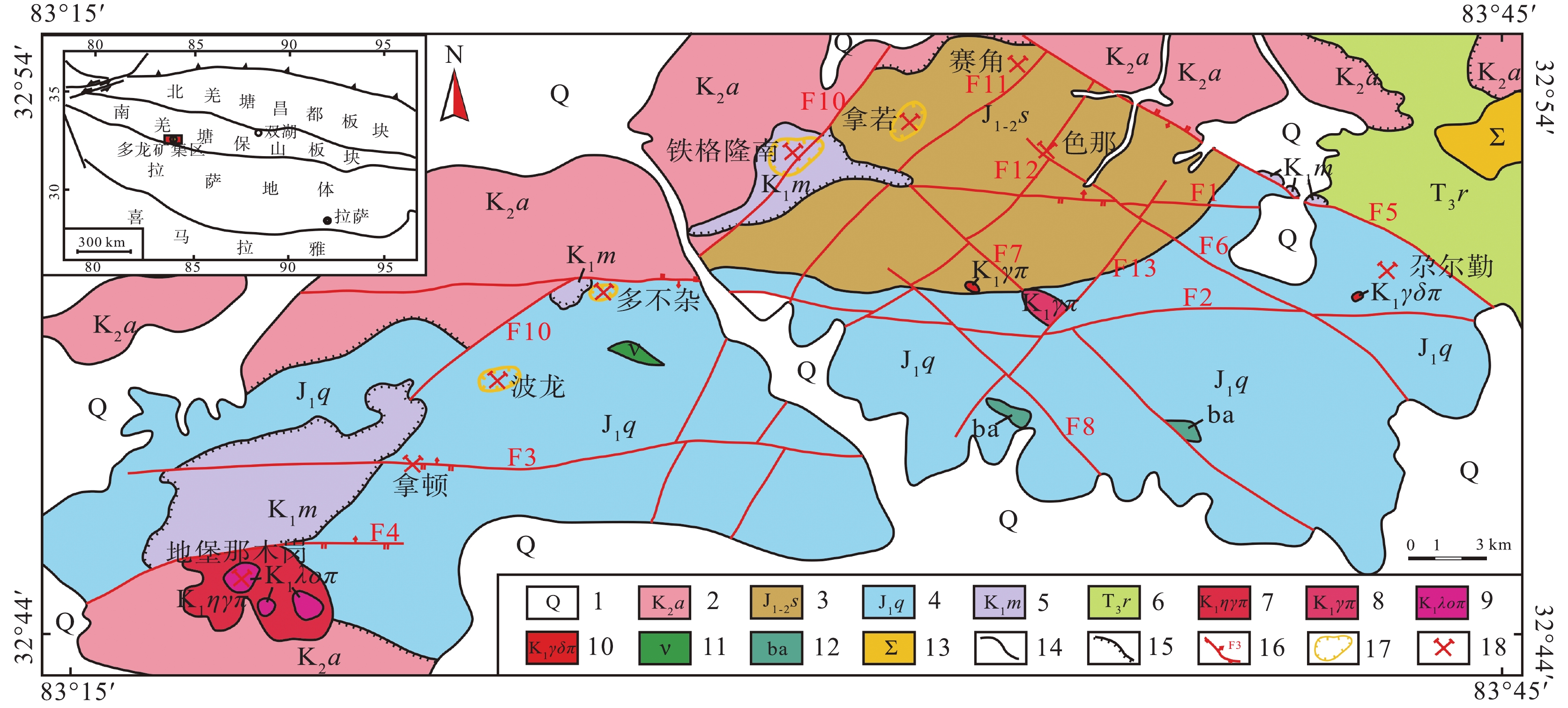
 下载:
下载:
